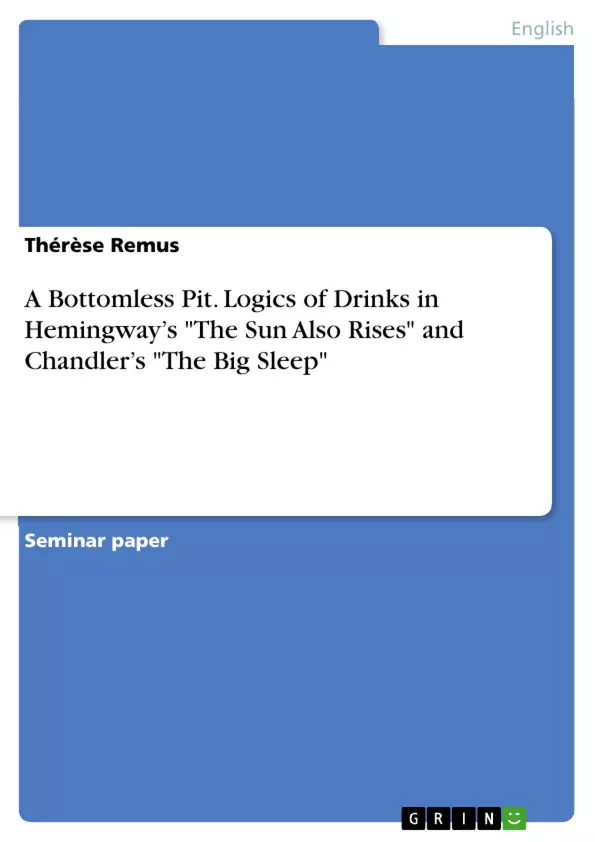Given that both authors, Hemingway and Chandler, represent a rather lean and reduced style, the extraordinary emphasis put on the recounts of drinking in both narratives is striking. This phenomenal contrast between the significant role of drink within the narrative and the sobriety of the narration on the level of style renders the depiction of scenes around drinking especially noteworthy. Much has been said about Hemingway being a dedicated and heavy drinker and thus literary criticism was often all too easily tempted to reduce the dominance of the topic of drinking in the novels to “… either the unavoidable … aspect of the Hemingway hero …, or [to a] barely mediated reinscription of the author’s private drinking habits” (Nicholls 2000 (b): 86). Another approach was taken by representatives of medical and sociological studies on the representation of alcoholism in mass media who understand Hemingway’s novel as a depiction of the expatriate scene in 1920s Paris and interpret the text as a promotion of drink as political attitude (cf. Room 1984: 543). These approaches, however, do not consider the functional employment of drink and respective rituals as fundamental elements of narrative structure apart from moral and medical connotations. They furthermore assume a highly simplified and homogenous quality of group dynamics on the level of the characters.
This essay follows argues against a reading of Hemingway´s novel as using drink to establish a moral evaluative system. Arguing that both Hemingway and Chandler construe drink as a social and physical code drawing on a complex inventory of gestures and discursive patterns, the essay identifies moments of the narratives which show the constant encoding and decoding of drinking as a communicative practice the logic of which serves to establish in- and out-groups according to why, when, what and how to drink.
In addition to shaping character interactions in a social sense, drink as a structural device functions in a physical sense as it serves as a material prompt for the characters to act out their roles. The strong and explicit focus on the portrayal of drinking habits and rituals adds a plasticity to the narratives which becomes significant especially with regard to Chandler and his style being highly influenced by cinematic aesthetics.
Inhaltsverzeichnis (Table of Contents)
- INTRODUCTION
- DRINKING IN THE SUN ALSO RISES
- DRINKING IN THE BIG SLEEP
- CONCLUSION
Zielsetzung und Themenschwerpunkte (Objectives and Key Themes)
This essay examines the significance of drinking in Ernest Hemingway's "The Sun Also Rises" and Raymond Chandler's "The Big Sleep", challenging interpretations that reduce the emphasis on drinking to mere authorial habits or depictions of social trends. It argues that both authors utilize drinking as a structural tool, shaping character interactions and narrative dynamics.
- Drinking as a social and physical code
- The role of drinking rituals in establishing in- and out-groups
- The use of drinking as a material prompt for character actions
- The interplay between drinking and verbal discourse
- The impact of drinking on the narrative structure and style
Zusammenfassung der Kapitel (Chapter Summaries)
- INTRODUCTION: The essay introduces the topic of drinking in Hemingway and Chandler's novels, highlighting the contrast between the prominence of drinking in the narratives and the sober style of the authors. It critiques interpretations that reduce the significance of drinking to authorial habits or social trends, advocating for a focus on its structural function.
- DRINKING IN THE SUN ALSO RISES: This section explores the complex interactions between characters as they engage in drinking rituals. It highlights how drinking serves as a discursive system with its own rules, creating a new kind of discourse that can either function or fail depending on shared understanding. The chapter analyzes the interactions between Jake, Brett, and the Count, demonstrating how each character follows a different code regarding drinking, leading to complicated communication dynamics.
Schlüsselwörter (Keywords)
This essay focuses on the key themes of drinking as a structural tool, social code, and communicative practice in Hemingway and Chandler's novels. It explores the role of drinking rituals in shaping character interactions, establishing in- and out-groups, and influencing narrative dynamics. The analysis draws on concepts from semiotics, Bourdieuian sociology, and narrative theory to understand the complex functions of drinking in these literary works.
- Quote paper
- Thérèse Remus (Author), 2014, A Bottomless Pit. Logics of Drinks in Hemingway’s "The Sun Also Rises" and Chandler’s "The Big Sleep", Munich, GRIN Verlag, https://www.grin.com/document/275606



